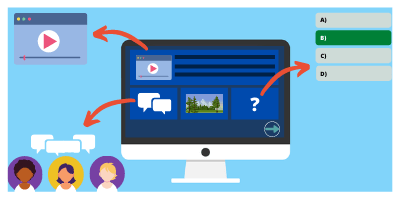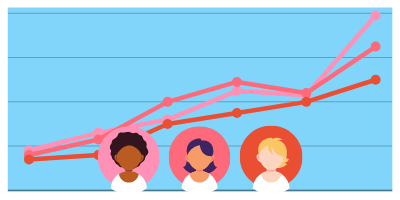Adding Interactivity: Getting Started
Adding interactivity to resources, whether this is to be used for group or independent work, can help improve student engagement as well as provide a variety of different learning opportunities. Adding elements of discussion, collaboration and practice to student learning activities can help students interact with content in more engaging ways. Below are some steps you can take to add interactivity to your resources to make them targeted, guided and purposeful.

![Planning Learning Activities Banner Image Text [Planning learning Activities]](https://digitaleducation.lincoln.ac.uk/files/2020/10/Planning-Learning-Activities-Banner.png)
One of the most common approaches for planning interactive and meaningful use of resources is to use the flipped-learning model; whereby students are asked to complete a task in advance of a synchronous session to give them a base-line of knowledge. Flipped learning is a great opportunity to use a pre-completed task to formulate a discussion or collaboration opportunity. It also enables you to chain multiple activities together, feed through to a culmination point. This approach can enable you to fully utilise your contact time for higher level tasks such as critical thought and discussion.
Try adding additional activities and aligning these to assessment outcomes to form an interactive learning journey to increase student motivation outside of the face-to-face element and potentially enhance student knowledge and application.
Asynchronous independent learning can also be used to support all students (whether they need extra support or stretch). This includes, additional remedial support for those students that may be struggling to grasp concepts, and allowing them to work independently through a learning activity may help them clarify and solidify certain areas of the curriculum. Use of data can help here, such as viewing statistics on videos, which may highlight a repeat viewing peak for certain topics requiring further clarification for some. For further guidance see the support pages on Using Data to Inform Teaching (web).
Equally, you might want to provide a more detailed content to challenge more capable students that are wanting to go above and beyond the curriculum – just be sure not to discourage or confuse other students.
![Collating & Structuring Content Image text [Collating & Structuring Content]](https://digitaleducation.lincoln.ac.uk/files/2020/10/Collating-Structuring-Content.png)
Begin by collecting resources that you could use for your module. Remember, you do not need to create all this content yourself. There is a range of content available to you and your students in the form of texts, video and web content.
Don’t worry if it isn’t exactly how you would teach it: A common barrier to re-purposing third-party content is that it may not exactly suit your learning outcomes/preference for detail. Why not incorporate this into the learning by making this clear with the students; make it explicit where you think a resource doesn’t go into sufficient detail and challenge the students to identify the missing elements. E.g. “This video gives a good overview of the topic, but doesn’t go into enough detail on [key point 1], compare this with the detail in the e-book text for this module”.
Below are some activitie ideas that can help students with reading, watching and doing (application).
Consider the use of E-books, websites, news articles, and journals. You can find a range of text-based content through the library search.
Consider the use of LinkedIn Learning videos and courses, documentaries on Box of Broadcasts, and videos on YouTube. Remember to be targeted and critical of the content; you can advise students to simply watch a section of a video before moving onto another resource.
Be explicit with what you expect students to do as part of the learning activity. If the answer is ‘make notes’, try providing a structure; theme and guided questions can help students create more detailed notes.

Making the learning visible means that both you and student peers can review and provide feedback on what your students are achieving. Asking students to share their outputs on platforms like Padlet or Blackboard discussion boards is a great way to quickly review their work, and can be used to direct discussion in synchronous sessions.
Alternatively, is there a way that students can self-assess their learning? The use of Microsoft Forms or Blackboard quizzes can provide great opportunities for students to check their understanding of a topic. You can quickly create multiple choice quizzes that are auto-graded and provide feedback on each question to encourage and support students.
Microsoft Forms are quick and easy to set up, but simply providing questions and model answers can be just as effective.
Setting asynchronous independent learning tasks shouldn’t be the same as assigning coursework for submission; not everything students do will need to be (nor can be) tutor-marked. Avoid increasing your workload unnecessarily by assigning additional tasks that require a large amount of follow up work afterwards.
However, it is vital to ‘close the loop’ by drawing together the asynchronous activities with the synchronous. Students will become demotivated if they are creating work that no one reads or they feel doesn’t align to the core learning. As such, automated marking strategies or peer-collaboration activities with summary overviews from you can prove more manageable strategies and help ‘close the feedback loop.’
This page is part of a collection. To see the other pages in the collection. Please click the button links below.
